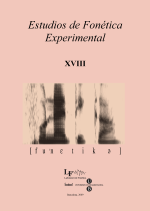La relevancia del tono intrínseco de las vocales en la entonación
Keywords:
micro-melodic variations, intrinsic pitch of vowels, intonationAbstract
Fundamental frequency (F0) is responsible of intonation and stress, in addition to some variations related with the influence of the specific configuration of segmental units. This article offers an evaluation of micro-melodic variations of vowels and explores its repercussion on the pitch contour. A phonetic experiment is offered in which the intrinsic pitch (F0I) is measured in a controlled context, taking into consideration the following variables: initial stressed position, final stressed position, pre-stressed position, and post-stressed position, as well as sentence modality (assertive or interrogative). Results moderately corroborate the universalistic theory of micro-melodic variation concerning the intrinsic pitch of vowels and they evidence the modest effect of this contour on the flow of intonation.
References
ALVARELLOS PEDRERO, M. (en prensa): Rasgos melódicos influyentes en la discriminación de la modalidad oracional. La relevancia lingüística del pretonema, Ed. del Departamento de Filología Española, Univ. de Oviedo.
BUENAFUENTES, C.; N. MADRIGAL y J. M. GARRIDO (2000): «Análisis acústico de las variaciones micromelódicas en las curvas del F0 en español», Español Actual, 73, pp. 65-77.
DI CRISTO, A. (1982): Prolegomènes à l’étude de l’intonation. Micromélodie, París, Éditions du CNRS.
DORTA, J. y B. FERNÁNDEZ (eds.) (2007): La prosodia en el ámbito lingüístico románico, Santa Cruz de Tenerife, La Página Ediciones, S. L. Universidad.
LADD, R. (1996): Intonational Phonology, Cambridge, Cambridge University Press.
LÓPEZ BOBO, M. J.; C. MUÑIZ CACHÓN; L. DÍAZ GÓMEZ; N. CORRAL BLANCO; D. BREZMES ALONSO y M. ALVARELLOS PEDRERO (2007): «Análisis y re- presentación de la entonación. Replanteamiento metodológico en el marco del proyecto AMPER» en J. Dorta y B. Fernández (eds.): La prosodia en el ámbito lingüístico románico, Santa Cruz de Tenerife, La Página, pp. 17-34.
MATEO, A. (1988): «Experimento sobre el tono intrínseco de las vocales castellanas», Estudios de Fonética Experimental, 3, pp. 157-180.
MOOSHAMMER, C.; P. HOOLE; P. ALFONSO y S. FUCHS (2001): «Intrinsic Pitch in
German: A puzzle?», 142nd Meeting of the Acoustical Society of America, Ft. Lauderdale, Florida.
http://www.ipds.uni-kiel.de/cm/pub/CM_ASA_2001.pdf.
MUÑIZ CACHÓN, C.; M. J. LÓPEZ BOBO; M. CUEVAS ALONSO; R. GONZÁLEZ RODRÍGUEZ y L. DÍAZ GÓMEZ (2006): «Entonación y límites sintagmáticos en secuencias con extensión variable en el objeto. Estudio del asturiano central», en M. Villayandre Llamazares (ed.): Actas del XXXV Simposio Internacional de la Sociedad Española de Lingüística, León, Universidad de León, en línea.
http://www3.unileon.es/dp/dfh/SEL/actas.htm
PAPE, D. y C. MOOSHAMMER (2004): «Intrinsic pitch in German. Examining the whole fundamental frequency contour of vowel», CFA/DAGA’04, Estrasburgo, pp. 897-98.
http://www.zas.gwz-berlin.de/mitarb/homepage/pape/paper/ pape_dag.pdf.
PAPE, D. (2005): «Is pitch perception and discrimination of vowels language- dependent and influenced by the vowels spectral properties?», en Proceedings of ICAD 05. Eleventh Meeting of the International Conference on Auditory Display, Limerick, Irlanda, pp. 340-343.
WHALEN D. H. y A. G. LEVITT (1995): «The universaltiy of intrinsic F0 of vowels», Journal of Phonetics, 23, pp. 349-366.
Downloads
Published
How to Cite
Issue
Section
License

This work is licensed under a Creative Commons Attribution-NonCommercial-NoDerivatives 4.0 International License.
All articles published online by Estudios de Fonética Experimental are licensed under Creative Commons Attribution-NonCommercial-NoDerivs 4.0 International (CC BY-NC-ND 4.0 DEED), unless otherwise noted. Estudios de Fonética Experimental is an open access journal. Estudios de Fonética Experimental is hosted by RCUB (Revistes Científiques de la Universitat de Barcelona), powered by Open Journal Systems (OJS) software. The copyright is not transferred to the journal: authors hold the copyright and publishing rights without restrictions. The author is free to use and distribute pre and post-prints versions of his/her article. However, preprint versions are regarded as a work-in-progress version used as internal communication with the authors, and we prefer to share postprint versions.




